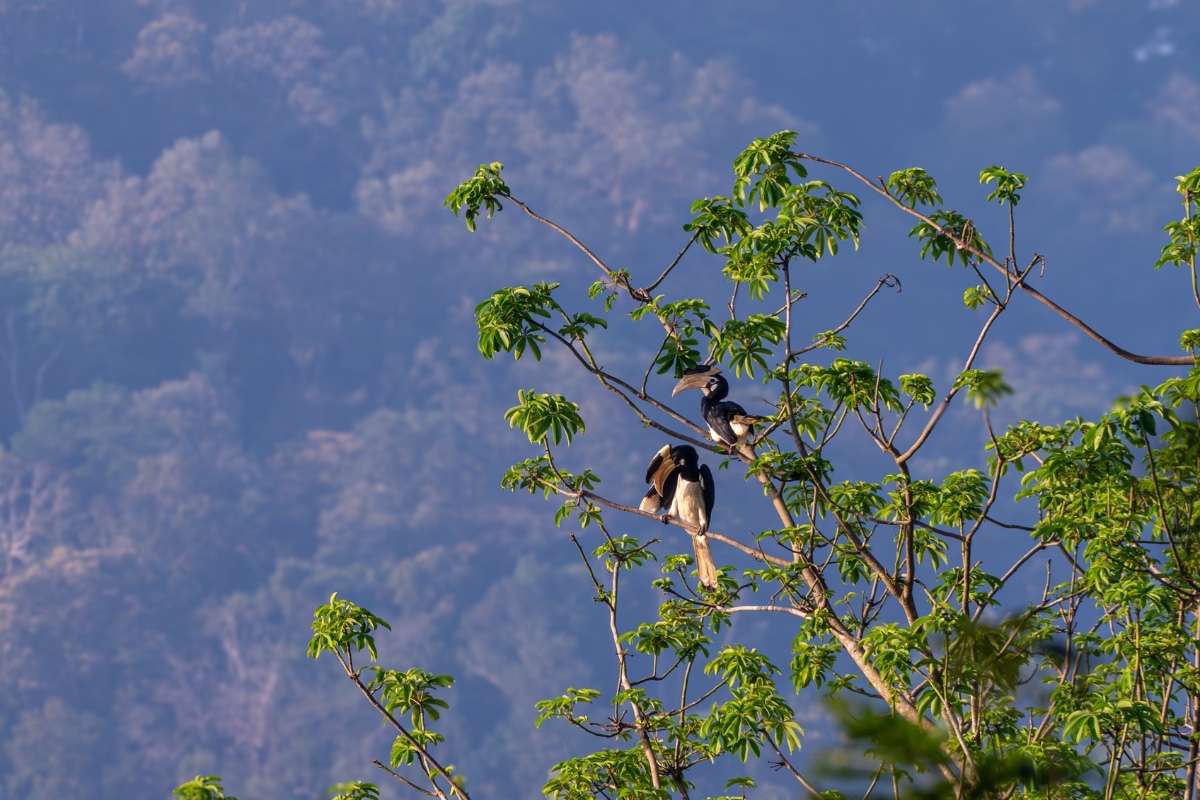This hornbill is thought to be one of the most common and smallest of the Asian hornbills. Its range is the broadest of the genus, encompassing both Southeast Asia and the Indian Subcontinent. Wet lowland forests with typically tropical or subtropical climates are its natural habitat. Its dietary sources include fruit, insects, seafood, small mammals, birds, reptiles, and their eggs. Hornbill is a medium-sized frugivore with a wingspan of 23–36 cm (9.1–14.2 in) and a head-to-tail length of 55–60 cm (22–24 in).The bill measures 19 cm (7.5 in) for males and 16 cm (6.3 in) for females.

Winged Glory A regal flight through blue.
Males typically weigh 900 g (32 oz), while females weigh 875 g (30.9 oz). Its weight ranges from 600 to 1,050 g (21 to 37 oz). Additionally, its feathers are black with a tint of green on the head, neck, back, wings, and upper breast. Notably, every feather has a black tail with white tips, except for the rectrices, which are the center feathers. Furthermore, they have white plumage on the underwing, thighs, lower breast, lower belly, and all wing tips, except for the two outer primaries and the three basal secondaries. They also have white skin on their throat and around their eyes.

Flying Free Graceful hornbill in flight over stunning peaks.
The necks of adults may seem blue. The casques, which are laterally flattened “cylinders” that mimic protruding horns, are a characteristic of mature hornbills. Males and females have similar coloration. Males are distinguished from females by their larger bodies, bright red eyes, and a yellow bill with a black base. In addition to having grayish-brown eyes, a yellow bill, and a partially black, brownish patched mandible, females are noticeably smaller than males Juvenile hornbills are similar to adults, except they have a smaller bill and a less developed casque.

Perched Majesty Pied Hornbill perched atop a tall tree.
Their black feathers lack the green luster of adults. Hornbills are monogamous and breed from January to June, whereas Hornbills start breeding in February. This coincides with the onset of rain and the peak of fruit production, depending on the area.

Branch Buddies: Pied Hornbills groom peacefully.
Hornbills, as secondary cavity nesters, use existing cavities from other birds or fallen branches. Their breeding success depends on the availability of suitable nest sites.

Loving Hornbills Hornbills share a sweet moment.
Females first select and enter their nest, then carefully seal the cavity with a mixture of fruit, tree bark, soil, and saliva, leaving only a small opening for nourishment. At the same time, the male actively forages for the female and the chicks, while the female continuously feeds the nestlings. Consequently, the chicks remain in the nest with the female for several months until they are finally ready to fledge.

Hornbill Squad A group of Pied Hornbills rests in trees.
Copyrights : All the photos and texts in this post are the copyright of John Thomas and Creative Hut Institute of Photography and Film. Their reproduction, full or part, is forbidden without the explicit approval of the right owners.


